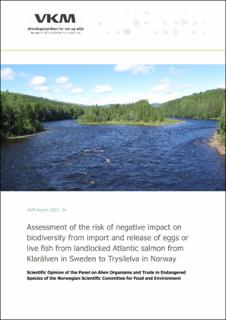| dc.description.abstract | Introduction Atlantic salmon in the River Klarälven in Sweden live the entire life in freshwater, undertaking feeding migrations to Lake Vänern. The upper part of the watershed is in Norway and comprises the River Trysilelva and associated rivers and lakes. Atlantic salmon previously lived in the Norwegian part of the watershed but were lost due to the construction of 11 hydropower stations that block the upstream migration from Vänern. The power stations also cause a high mortality among downstream migrating fish. Tagging studies showed that there is 71-84% mortality of juveniles (smolts) and 100% mortality of adults during downstream migration past the eight lowermost power stations. Extensive mitigation measures are needed to reduce the mortality of downstream migrants and reestablish a population that can reach areas in Norway naturally without being captured in Sweden and transported to Norway. In 2015, the total costs of establishing fishways bypassing the power stations and securing safe downstream migration was estimated to be 1000 million SEK. To compensate for a decline of salmon due to lost habitat, hatchery-produced juveniles have been released in the watershed for more than 100 years, and adult salmon have been captured in the lower reaches of Klarälven and released in upstream reaches. After the Höljes power station was built, 80% of the salmon transported upstream were released upstream of Höljes. In 1993, the Norwegian government stopped these releases due to the large mortality of downstream migrating fish at the power stations. The releases had already been stopped from late summer 1988 due to bacterial kidney disease (BKD) outbreaks in salmon populations in the watershed. Since 1988, transported fish have been released upstream of Edsforsen in Sweden, and have not been able to reach Norway. Aim of report The Norwegian Environment Agency asked VKM to carry out a risk assessment of three specified methods that can be used to reestablish salmon in the Norwegian part of the watershed. This risk assessment is pertinent because the occurrence of alien organisms and infectious agents have developed differently in the Swedish and Norwegian parts of the watershed after salmon became unable to migrate through the river system. In 2013, the fish parasite Gyrodactylus salaris was detected in Klarälven, but has not been recorded in Norwegian parts of the watershed. Here, we assess the risk of negative impacts on native biodiversity by importing Atlantic salmon eggs or live adults from Klarälven to Norway. Three methods of importing eggs or adults were assessed: I. Import of fertilised eggs to a local hatchery in Norway, which are planted in the river in the spring or hatched and released as juveniles or smolts. II. Import of fertilised eggs that will be used to establish a long-term broodstock in Norway using the gene bank model, from which eggs can be planted into the river, or transferred to a local hatchery with subsequent release of juveniles or smolts. III. Import of adult salmon spawners that are captured in the lower parts of Klarälven in Sweden, transported in tanks and released in the Norwegian parts of the watershed. Methods The risk assessment was based on a literature review and qualitative assessment of each of the three methods of importing eggs or adults. The risk of impacts on native biodiversity and ecosystems was assessed for infectious agents, including parasites, bacterial pathogens, and viruses, and for other alien species. For each of the infectious agents and alien species, the risk is based on the product of the magnitude of the potential negative impact to native biodiversity and ecosystems, and the likelihood that negative consequences occur. The risk assessment concludes in terms of low, moderate, or high risk. ....................... | |
